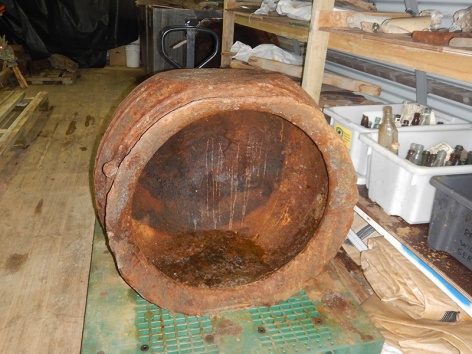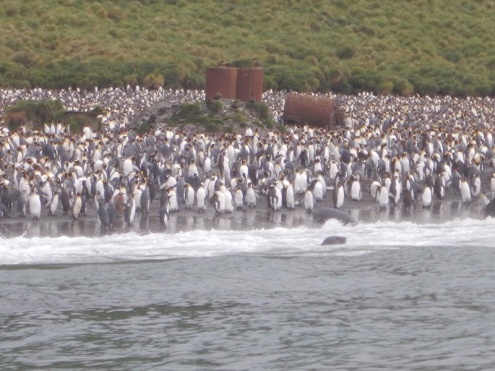Just as in the 20th and 21st centuries our industries and economies are fueled by natural gas and the hydrocarbons of petroleum mineral oil, the 18th and 19th centuries were greased, oiled and illuminated by the organic blubber and oil of elephant seals, whales, walruses and penguins. Fur seals were targeted their warm and resilient coats, while the bones, ambergris and teeth of whales were transformed into fashionable necessities.
The Industrial Revolution saw a sudden and insatiable demand for stable oils for machinery and manufacturing, and the emerging middle class wanted to be able to light their homes with clear burning lamps, pinch their waists in whalebone corsets and wear warm furs.
The oils and other products derived from the sealing and whaling trades were in such high demand in Europe, America and colonial settlements they became one of the most lucrative and high risk trades of the 19th century, especially in the southern colonies of Australia and New Zealand. In the first 30 years of European settlement in Australia, large shipping companies from England and America were quick to purchase ships and crews out of Sydney to take advantage of the rich sealing and whaling opportunities of the Southern Ocean.

A try-pot used for rendering down seal blubber on Macquarie Island
Macquarie Island was first documented by Fredrick Hasselbourgh, Captain of the Perseverance, in 1810. His ship was a sealing brig owned by the shipping giant Campbell & Co., based in Sydney, and on this journey he was charged with looking for new sealing grounds to exploit south of New Zealand. He returned to Sydney in August 1810 and reported to his employer of finding an uninhabited island in the high southern latitudes supporting a huge population of fur seals, elephant seals and penguins. Although this discovery wasn’t made public, news got around fast in shipping circles and by the middle of October that year six ships had set out to take advantage of this new source of furs and oil (McNab 1907 p.118). The Perseverance was the first to report the existence of the island, but was not the first ship to reach it. Hasselbourgh left a sealing gang on the island and when he returned to collect them and their harvest, they reported finding the remains of a wooden ‘ancient ship’. The wreckage was salvaged and used for firewood by sealing gangs before it could be properly documented, so the origins of this first landing at Macquarie Island will never be known. Unlike some of the New Zealand Subantarctic islands Macquarie Island has no known history of pre-colonial occupation, but was one of the earliest sites of European occupation in Australia’s territories. In 1825 Tasmania took responsibility for the island from New South Wales, however while Sydney, Hobart and the other settlements in Australia at that time were administered by governments, the initial occupation of Macquarie Island was a purely commercial enterprise.
The flotilla of commerce to tear out of Sydney in October 1810 was just the beginning of the island’s exploitation. The next 10 years saw Macquarie Island so heavily plundered the fur seal population was wiped out by 1820. Although fur seals began to re-populate the island in the 20th century, there was no record made of which species of seal were found on the island when it was first discovered. It is still unknown if the fur seal population on the island in 1810 was a now extinct species, or the species that have since re-populated the island.

Elephant seals and penguins crowd the beach at Buckles Bay, the main site of historical oiling operations and today’s station base. I didn’t see any fur seals, but they can be found on the island in small numbers.
With the fur seals no longer providing a ready harvest, the next resources on the island to be exploited were the blubber and oil of elephant seals and penguins. Elephant seals were abundant and relatively easy to kill, but removing and rendering down their blubber was heavy work. In the 1830’s the elephant seal population was estimated to have reduced by 70%, and between that decade and 1874 only three ships are known to have visited the island for sealing. By then, the population had recovered enough for it to be considered worthwhile to start harvesting again. In 1891 the Tasmanian government issued a ban on seal harvesting on Macquarie Island, but due to its remoteness it was almost impossible to reinforce. Before long the seal population began to shrink once more, and the entrepreneurial eye turned to the potential of the islands millions of penguins as a source of oil.

King penguins throng around rusted ‘digesters’ at Lusitania Bay
From the 1880’s, King, Gentoo and Royal penguins were rounded up, clubbed, and piled whole into giant macabre vats known as Penguin Digesters which did just that – render down the penguins for their oil, fuelled by a fire of elephant seal blubber, or their digested neighbours. Up to 2000 penguins could be crammed into one digester, with the oil used mainly in the shipping industry. Each penguin could produce about 1 pint (approx. 400ml) of oil. Nuggets Penguin Processing Plant on the island’s north was the main point of this activity, and at the time (1880’s – 1920) the ‘steam digester’ was considered state of the art technology. Penguin harvesting on Macquarie Island was banned in 1920 after the last oiling license, held by Joseph Hatch was not renewed and the population has recovered significantly. Whaling was never a trade pursued at Macquarie Island, due to the lack of a suitable harbour.

Penguin digesters with interpretive signage about Joseph Hatch and his oiling scheme
With the ban on harvesting penguins, elephant and fur seals in place for decades, their populations on Macquarie Island have recovered significantly. But like the rest of the island’s ecosystem, these animals are experiencing the pressures of climate change. Changes to their diet from the impacts of climate change on food webs and species distribution have been indicated in a declining population of elephant seals. The work of scientists and rangers is imperative in monitoring and understanding the impacts of climate change on the animal populations of Macquarie Island, and what the future may hold for this isolated, but globally connected island.
